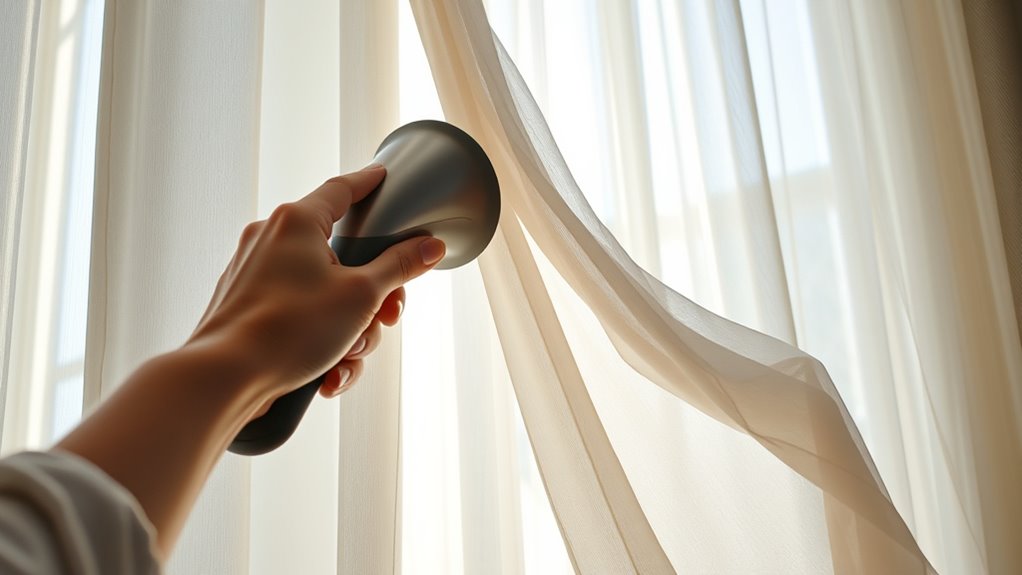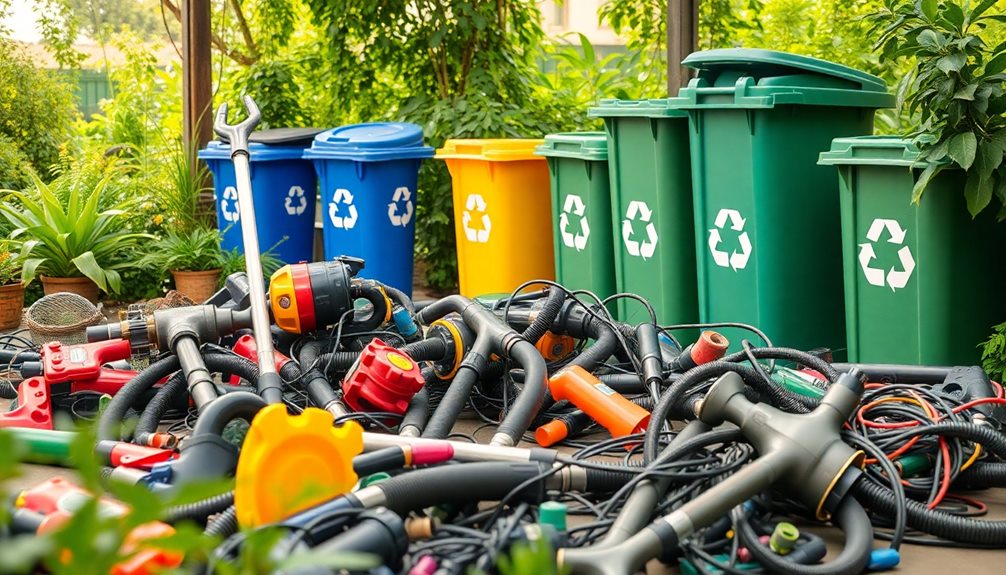To vacuum your curtains safely, start by choosing a soft brush or upholstery attachment and set your vacuum to a moderate suction. Close the curtains, identify delicate details, and vacuum from top to bottom with gentle, sweeping motions, paying special attention to folds and seams. Vacuum each layer separately if needed. Doing this weekly helps prevent dust buildup and fabric damage. For more tips on maintaining your curtains, keep exploring the full guide.
Key Takeaways
- Use a soft brush or upholstery attachment with low suction to gently clean delicate fabrics.
- Vacuum from top to bottom in light, sweeping motions, focusing on folds, pleats, and seams.
- Remove or secure decorative elements and vacuum each layer separately for thorough cleaning.
- Avoid pressing hard and stay in one spot to prevent fabric damage or wear.
- Vacuum weekly to maintain fabric appearance, prevent dust buildup, and prolong curtain lifespan.

Vacuuming curtains is an easy and effective way to keep them clean and free of dust, allergens, and pet hair. Regular vacuuming not only improves your home’s air quality but also helps with dirt removal and fabric maintenance. When you vacuum curtains properly, you prevent dust buildup that can cause allergies or respiratory issues, especially if you or family members are sensitive. It’s a simple task that makes a noticeable difference in the overall cleanliness of your space.
Vacuuming curtains keeps them clean, allergen-free, and prolongs fabric life effortlessly.
Start by selecting the right vacuum attachment—preferably a soft brush or upholstery tool. These are gentle enough to avoid damaging delicate fabric while still lifting dirt effectively. Before you begin, close the curtains to their full length to access as much surface area as possible. Gently run the vacuum over the fabric, using light, sweeping motions. Pay extra attention to folds, pleats, and seams where dust and pet hair tend to accumulate. Make sure you don’t press too hard or stay in one spot too long, as this can cause wear or damage over time.
For best dirt removal, work from top to bottom. This way, any loose particles dislodged will fall downward, and you can vacuum them up easily. Be thorough but gentle—curtains are often made from delicate fabrics that can tear or fray if handled roughly. If your curtains are heavily soiled or have stubborn dust, consider using a handheld vacuum with adjustable suction. Keep the vacuum’s suction level moderate to avoid pulling or stretching the fabric. Regular vacuuming sessions, about once a week, help maintain the fabric’s appearance and prolong its lifespan, making routine fabric maintenance effortless.
If your curtains have decorative elements like fringes or embroidery, take extra care around those areas. Use a softer brush or a low-suction setting to prevent damage. For curtains with multiple layers or lining, you may need to vacuum each layer separately to ensure thorough dirt removal. Remember, the goal is to keep your curtains clean without compromising their integrity.
Vacuuming also helps extend the life of your curtains by removing particles that can cause fabric deterioration over time. It’s a quick, non-invasive cleaning method that saves you from more intensive cleaning methods, which might risk damage. Additionally, regular vacuuming can help eliminate potential security threats like dust that could interfere with electronic components such as smart home devices. With consistent and careful vacuuming, you’ll keep your curtains looking fresh and well-maintained, enhancing your home’s cleanliness and comfort. Just make sure you’re gentle, thorough, and regular, and your fabric will thank you for the care.
Frequently Asked Questions
How Often Should I Vacuum My Curtains?
You should vacuum your curtains at least once every two to four weeks to keep dust accumulation and allergen buildup under control. Regular vacuuming helps remove dust, pet dander, and other allergens that settle on fabric, improving indoor air quality. Use a gentle brush attachment to prevent damage. If you notice more dust or allergies worsening, consider vacuuming more often to maintain a healthier environment for you and your family.
Can Vacuuming Damage Delicate Curtain Fabrics?
Think of delicate fabrics like glass—beautiful but fragile. Vacuuming can damage curtains if you’re not careful, especially with fabrics that have low elasticity. You might notice static buildup or even tears if you press too hard. To protect your curtains, use a gentle setting and a soft brush attachment. Proper technique guarantees you remove dust without compromising fabric integrity or elasticity.
What Attachments Are Best for Vacuuming Curtains?
When choosing attachment options for vacuuming curtains, you want gentle, soft tools that won’t damage delicate fabrics. A brush or upholstery attachment works best because it cleans without pulling or tearing fibers. Always consider fabric considerations—if your curtains are very fragile, opt for a handheld vacuum or a soft brush attachment. This way, you keep your curtains clean while protecting their texture and integrity.
Should I Vacuum Curtains While They Are Hanging or Removed?
Consider your curtains’ fabric types and vacuum techniques before deciding to vacuum while hanging or removed. Generally, you should vacuum curtains while hanging to avoid damage, especially with delicate fabrics. Use gentle, light vacuuming with the appropriate attachment. If fabrics are fragile or heavily soiled, removing them for a thorough clean might be safer. Always test a small area first to make certain your vacuum techniques won’t cause harm.
Can Vacuuming Replace Professional Curtain Cleaning?
Vacuuming can’t fully substitute for professional curtain cleaning, especially for delicate or heavily soiled fabrics. It’s great for routine dust removal, but for deep cleaning, professionals use specialized methods suited to your curtain material. Always adjust your vacuum settings to low or delicate to prevent damage. Regular vacuuming maintains freshness, but occasional professional cleaning guarantees your curtains stay spotless and in top condition.
Conclusion
Now that you know how to vacuum your curtains safely, you can keep them clean and fresh without worry. Regular vacuuming prevents dust buildup and maintains their appearance. Isn’t it worth taking a few minutes to protect your fabric and breathe easier? With these simple steps, you’ll extend the life of your curtains and enjoy a cleaner home. So, why not start today and make curtain cleaning an easy part of your routine?









